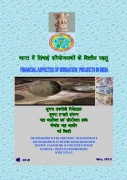/topics/governance
Governance
Study of ancient water storage systems on forts in Nashik district of Maharashtra - Paper presented at the National Seminar on Water and Culture (2007)
Posted on 14 Feb, 2011 05:11 AMThis paper studies the water supply, distribution, collection and storage in the forts around Nashik with the idea of testing the viability of implementing such systems in areas of similar topography. The history of forts in Maharashtra and the forts around Nashik and the water collection and distribution systems thereof are described.
Water and culture vis-à-vis river diversions - Paper presented at the National Seminar on Water and Culture (2007)
Posted on 14 Feb, 2011 04:48 AMThis paper discusses river linking, as a part of an ancient tradition, and suggests how NGOs can play a role in this attempt. The example of the Koyna dam is taken, and the effective handling of the technical and human angle of the dams construction is detailed through in-depth study and detailed field visits.
Participatory Irrigation Management (PIM) in Andhra Pradesh - An overview - Paper presented at the National Seminar on Water and Culture (2007)
Posted on 14 Feb, 2011 02:57 AMThis paper describes a PIM initiative undertaken by the Government of Andhra Pradesh. The need for PIM in Andhra Pradesh, was felt because farmers, especially those in the lower reaches of the command area of the project, suffer from inadequate and unreliable supplies.
Non-compliance of dam agencies in construction of hydro-electric projects in Himachal Pradesh - A photo-essay by SANDRP
Posted on 13 Feb, 2011 03:02 PM
Download the photo essay:
Financial aspects of irrigation projects in India – A report by the Central Water Commission
Posted on 13 Feb, 2011 08:28 AM This publication by the Central Water Commission presents data on Major and Medium Irrigation and Multipurpose projects, Minor Irrigation projects, Command Area Development scheme as available in the Finance A
This publication by the Central Water Commission presents data on Major and Medium Irrigation and Multipurpose projects, Minor Irrigation projects, Command Area Development scheme as available in the Finance A
State Forest Policy of Jammu and Kashmir (2010)
Posted on 12 Feb, 2011 08:33 PMIn the backdrop of the essential need for maintaining a healthy forest resource, the valid concern for its continued depletion and degradation, and, being aware of the close association between people and forests, the Forest Department (Government of Jammu and Kashmir), has recently adopted a Forest Policy.
Coastal Regulation Zone (2011) Notification, Island Protection Zone (2011) Notification and Traditional Coastal and Marine Fisherfolk (Protection of Rights) Act (2009) by the Ministry of Environment and Forests
Posted on 11 Feb, 2011 09:22 PMThe Coastal Regulation Zone (CRZ) notification of 1991 has been replaced recently in January 2011 by the latest CRZ notification of the Ministry of Environment and Forests (MoEF).
Water jobs via DevNetJobsIndia.org dated 8th February, 2011
Posted on 10 Feb, 2011 11:52 AMContent Courtesy: DevNetJobsIndia
- Water Supply and Sanitation Specialist
Population Foundation of India (PFI)
Location: Chattisgarh, Rajasthan, Madhya Pradesh, Uttarakhand
Last Date: 13th February, 2011
- Senior Researchers for Rural Water Programme
Centre for Science and Environment (CSE)
Location: New Delhi
Last Date: 1st March, 2011
Indicorps 2011 Fellowship - Application Deadline: 15 March, 2011
Posted on 10 Feb, 2011 10:57 AMFor 12th Indicorps Fellowship class beginning this August, there are 27 challenging openings all across the country from Punjab to Tamil Nadu and Gujarat to Bihar with projects focusing on environment, education, microfinance, community development, public health, women’s empowerment and more. As an intense, total-immersion leadership program, Indicorps encourages individuals of Indian origin to explore their role as a catalyst for change.
Eligibility:
For the 2011 fellowship year (as per Government of India's definition), Indicorps will accept applications from qualified persons of Indian origin who have a university degree or five years of applicable work experience from anywhere in the world.
Watershed prioritisation atlas for Maharashtra
Posted on 09 Feb, 2011 07:34 AMThis document by the Maharashtra Remote Sensing Applications Centre (MRSAC) presents the “Atlas on Watershed Prioritisation” using resources database on 1:2,50,000 scale adopting a





